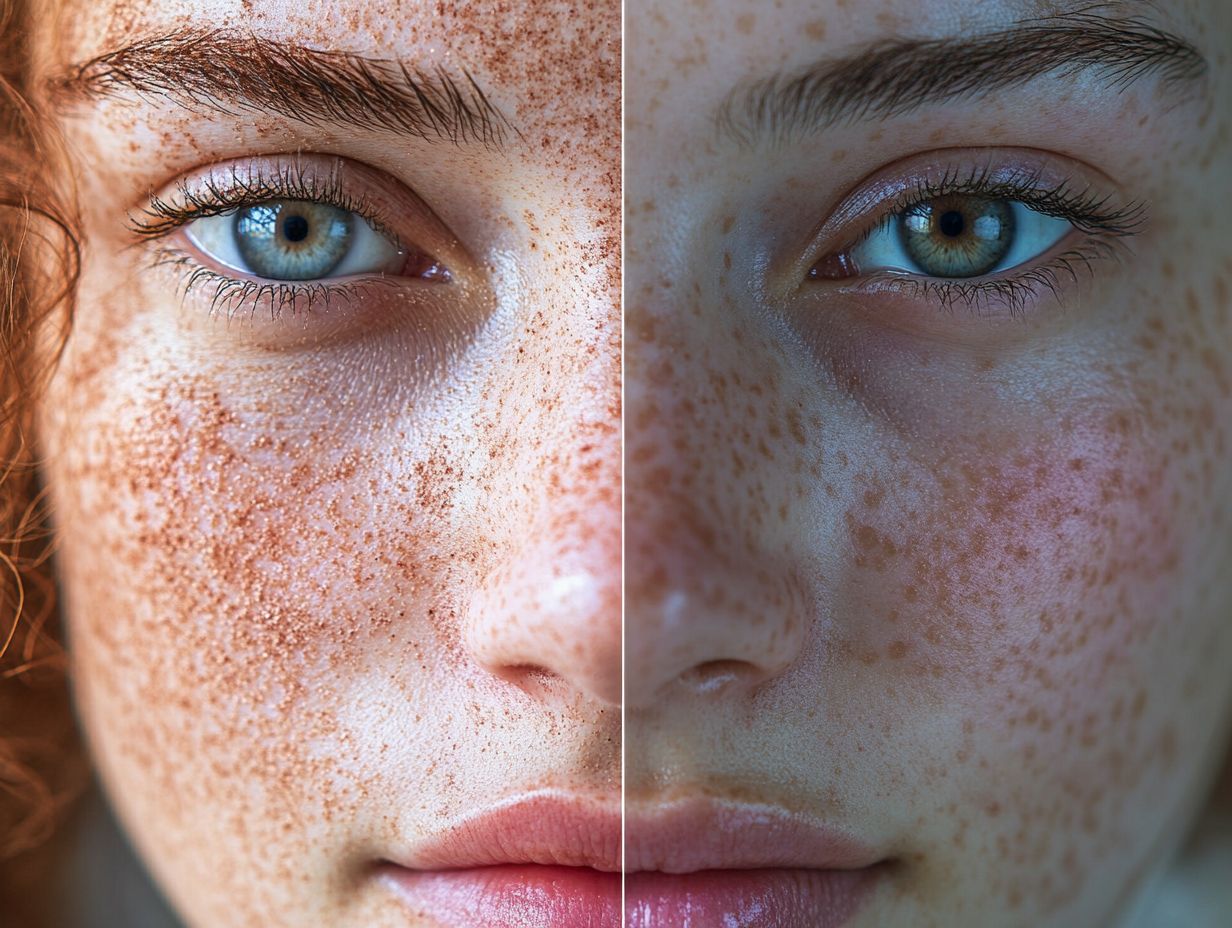Combination skin can be a bit of a puzzle, often leaving you wondering how to address both dry patches and oily areas.
This unique skin type requires a tailored approach to skincare, as it presents its own set of challenges.
Explore what combination skin is, the genetic and environmental factors behind it, and how to identify your specific skin needs.
Discover effective skincare routines, products, and lifestyle changes that can help you achieve a balanced and healthy complexion.
Whether you’re battling acne or dry patches, there are solutions available!
Key Takeaways:

Understanding Combination Skin
Understanding combination skin is essential for effective skincare, as it represents a distinct skin type that exhibits characteristics of both oily and dry skin. Typically, the T-zone—which includes the forehead, nose, and chin—tends to be oily, while other areas may exhibit dryness or sensitivity.
This duality can present challenges in maintaining skin health and necessitates a customized skincare regimen that addresses these varying needs. Therefore, it is imperative to utilize balanced skincare products to achieve optimal results.
What is Combination Skin?
Combination skin is defined as a skin type that features both oily and dry areas, often resulting in a varied texture that can present management challenges.
For example, the T-zone—comprising the forehead, nose, and chin—may display an oily sheen, while the cheeks and surrounding areas may feel dry or sensitive. This duality distinguishes combination skin from typical oily skin, which generally presents a consistently greasy texture, and from dry skin, which is often tight and flaky throughout.
Individuals with combination skin frequently encounter concerns such as enlarged pores or breakouts in the oily areas, along with dryness or redness in the drier regions.
Developing a tailored skincare routine to address these contrasting issues is essential for achieving a balanced complexion.
Causes of Combination Skin

The causes of combination skin are multifaceted and may be influenced by a combination of genetic and environmental factors. These elements contribute to the varying levels of oiliness and dryness observed in different areas of the face.
Genetics and Environmental Factors
Genetics significantly influence skin type, with certain individuals predisposed to combination skin due to inherited traits. This genetic influence is evident in various aspects, including oil production, pore size, and moisture retention, all of which substantially shape the overall appearance and behavior of the skin.
It is essential to acknowledge that environmental factors also play a critical role in skin health. For example, climate can greatly affect skin condition; individuals residing in humid regions may experience increased oiliness, while those in arid climates often contend with heightened sensitivity and dehydration.
Moreover, pollution and lifestyle choices, such as dietary habits and sun exposure, can either exacerbate or alleviate issues associated with combination skin. Research indicates that significant exposure to pollutants can compromise the skin’s barrier, resulting in heightened oiliness in the T-zone and dryness in other areas.
Experts recommend the incorporation of protective skincare routines and the adoption of healthier lifestyle choices to mitigate these effects, illustrating the complex interplay between genetics and environmental factors in determining skin characteristics.
Identifying Your Skin Type
Identifying one’s skin type is a crucial step in formulating an effective skincare regimen, particularly for individuals with combination skin.
This type necessitates a nuanced understanding of both oily and dry areas to ensure appropriate care and treatment.
Assessing Dryness and Oiliness

Assessing dryness and oiliness in combination skin requires a thorough examination of various facial areas to identify signs of excess oil production or insufficient moisture.
The T-zone, which includes the forehead, nose, and chin, typically exhibits a shiny appearance that indicates oiliness. In contrast, the cheeks may present signs of flakiness or tightness, which are indicative of dryness. Additionally, it is important to evaluate skin sensitivity by observing any redness, irritation, or discomfort that may arise from environmental factors or the use of harsh products.
Understanding these unique characteristics is crucial, as it facilitates the selection of appropriate skincare products tailored to individual needs, thereby ensuring balanced hydration and optimal skin health.
Caring for Combination Skin
Caring for combination skin necessitates a balanced skincare routine that effectively addresses both oily and dry areas. It is essential to select products that are specifically formulated to meet the diverse needs associated with this particular skin type.
Skincare Routine and Products
An effective skincare routine for combination skin should incorporate a diverse range of products tailored to address both oily and dry areas, with a primary focus on hydration and oil control.
To achieve this balance, experts recommend the use of oil-free moisturizers that deliver hydration without clogging pores, particularly gel-based formulations containing hyaluronic acid. A notable option is the Neutrogena Hydro Boost Water Gel, which is frequently endorsed by dermatologists for its lightweight and non-greasy finish.
For addressing specific dry patches, a cream such as CeraVe Moisturizing Cream is advisable, as it is rich in ceramides that assist in restoring the skin barrier.
To further enhance the skincare routine, the inclusion of a hydrating mask, such as the Tatcha Luminous Dewy Skin Mask, can provide a significant boost, especially following exposure to harsh environmental conditions.
Research indicates that maintaining optimal moisture levels in combination skin contributes to a more balanced complexion overall.
Dealing with Common Issues

Addressing common concerns such as acne and dry patches presents a significant challenge for individuals with combination skin. This condition requires targeted strategies for effective breakout management and skin treatment.
Acne, Dry Patches, and Other Concerns
Acne and dry patches are prevalent concerns for individuals with combination skin, necessitating a careful balance in treatment strategies to prevent worsening either condition.
Individuals dealing with these skin challenges often experience frustration, as the pursuit of a clear complexion can appear unending. Acne may arise from factors such as hormonal imbalances or clogged pores, while dry patches can be triggered by environmental factors or the use of harsh skincare products.
To effectively address these issues, it is essential to implement a multifaceted skincare regimen. Gentle cleansers and exfoliants can assist in managing acne without depleting the skin of necessary moisture. The incorporation of hydrating serums enriched with hyaluronic acid can alleviate dry patches, while non-comedogenic moisturizers help maintain skin balance. For more information on how to care for combination skin, check out this guide on Combination Skin: Balancing Dryness and Oiliness.
Natural remedies, such as aloe vera and tea tree oil, can provide soothing effects and promote healing without the adverse side effects associated with harsher treatments. By adopting the appropriate approach, individuals can attain a more even complexion and revitalize their skin.
Lifestyle Changes for Balancing Skin
Implementing informed lifestyle changes can greatly enhance the health of combination skin, fostering balance through intentional dietary choices and daily practices that contribute to overall skin wellness.
Diet and Habits for Healthy Skin
A well-balanced diet that is rich in antioxidants and essential oils plays a crucial role in maintaining healthy skin, particularly for individuals with combination skin.
Incorporating specific foods into daily meals can significantly enhance skin vitality. Hydration is of paramount importance; consuming adequate amounts of water aids in flushing out toxins and maintaining skin plumpness and elasticity.
Vitamins A, C, and E are essential as they contribute to skin repair and protection against environmental damage. Foods such as berries, nuts, and avocados can be easily integrated into the diet, providing not only antioxidants but also healthy fats that nourish the skin from within.
Additionally, essential oils such as tea tree and lavender can offer supplementary benefits when included in skincare regimens. These oils help to balance oil production and soothe inflammation, thereby further improving the overall complexion.


